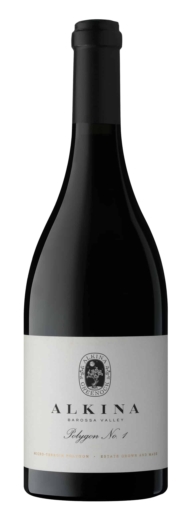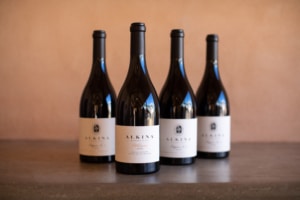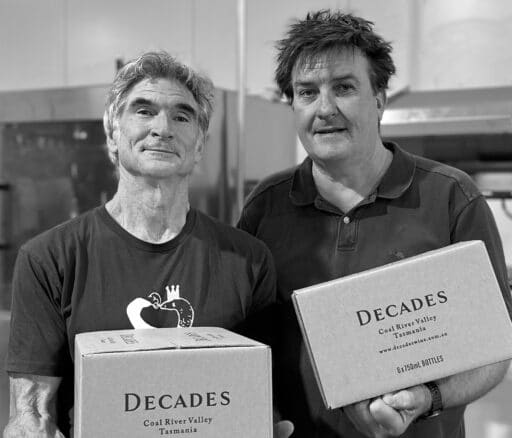
Alkina is a curious box of paradoxes. Seemingly unlimited resources but still tiny; a small local operation yet part of an international empire; located in Australia’s home of Shiraz, the Barossa, and yet Grenache is the focus (okay, Shiraz is also key); in the days of rockstar winemakers, an operation which could surely attract any talent they wanted works largely on a community basis with the employees all contributing; and in the days, and region, where no self-respecting wine would not spend a healthy incubation in oak, Alkina use hardly any.
Whatever they are doing and why, they need to keep going. The results are spectacular. Alkina is part of Argentinian billionaire, Alejandro Bulgheroni’s empire. For a wine empire, estimated to be worth around one billion dollars that includes more than a dozen wineries on four continents, with almost 4,500 hectares under vine, it has all happened amazing quickly – around fifteen years. It all started back in 2006 when Bulgheroni, who did not drink, was looking out over his latest windfarm in Uruguay. One of his advisors suggested that the place would work even better as a vineyard. Bulgheroni undertook some research and was advised to consult Alberto Antonini, one of the world’s most respected winemakers, having previously worked with Frescobaldi and been chief winemaker at the famous Tuscan estate, Antinori. Estates in Argentina, California, Italy, France and now Australia followed.
Antonini was on board and was soon joined by legendary French wine consultants, Michel Rolland and Philippe Melka, to work with Bulgheroni’s Bordeaux and Californian projects. In 2008, he entered into a JV in Argentina. A second Argentinian estate joined the portfolio in 2012. Also in 2012, he purchased Dievole, the Chianti Classico estate, which dates back to 1090. The Brunello estates of Poggio Landi and Podere Brizio, both in Montalcino, followed. Then to Bolgheri, in 2015, to purchase Tenuta I Pianali. Meanwhile, in 2013 he picked up two Bordeaux estates, Côtes de Bordeaux Château Suau and Château Langalerie. In 2011, he added Renwood Winery in California’s Sierra Foothills region, already one of the largest producers in that region and five years later, what was the ‘Founders Room for Harlan Estate’, renaming it ‘Lithology’. Alkina followed in 2015 and a project in Patagonia is underway (apparently ice wine is on the agenda). The focus is very much on “classic wines”, but that does not mean that some of these estates have not seen the addition of luxury resorts, top restaurants and golf courses.
The original Alkina Estate, which had old farmhouses, 170 years old, in need of some TLC, dates backs to the 1850s. It consists of more than 100 acres in the Barossa – 15 acres of old vines dating back some 70 years, 15 more of vines planted in 1998, 45 hectares of new plantings and another 50 acres added by way of an auction in 2017. One small winery has been constructed and there are plans for another. ‘Alkina’ is an Indigenous girl’s name meaning ‘Moon’.
The energetic and focused Amelia Nolan runs the operation. Antonini oversees winemaking support, but one of the most important members of the team (well, a consultant who occasionally flies in and out, if you like), is soil expert, Pedro Parra from Chile. Pedro, who recently released a thorough exploration of soils and terroir in his book, ‘Terroir Footprints’, has been dubbed the ‘Indiana Jones of the wine industry’. He holds a PhD in Precision Agriculture and Terroir) from the Institut Agronomique National in Paris (who even knew that there was such a thing?). Pedro is well known for digging holes. He has dug them in vineyards, and prospective vineyards, all over the world. The team call them Pedro Pits (he has dug well over one hundred at Alkina alone).
This has allowed for an examination of soils which rather reminds me of what centuries in Burgundy have achieved. Through the Pedro Pits, the team understand why one row works so well while the row next to it provides bog average quality. They know what to plant where. The alternative was to do as Burgundy did and work it out over 500 years. This seems easier. Pedro consults around the world and has been quoted as saying when it comes to wine, “rocks matter most” (he seems to have little interest in the topsoil). Pedro had long been keen to work with an Australian operation, as his perception of Australian wines were that they were too heavy. He wanted to offer a different interpretation. He is assisted by Paul Krug. Yes, from that family (Olivier’s son).
Alkina works on an organic and biodynamic basis and, as mentioned, they have taken a serious interest in Grenache. Half a century ago, legendary winemaker Peter Lehmann was a big fan of the Grenache from this very property. The other key varieties used here are Shiraz and Mataro. They see their terroir as influencing the character of that Grenache – limestone gives forth red fruit notes, while clay and schist offer darker fruits and black cherries. Grenache’s typical chalky tannins are present, though in varying degrees.
There is so much more going on here. A research program on local insects, a planting regime for some 1200 new native shrubs and grasses along the banks of Greenock Creek, fermentation in qvevri (Georgian fermentation vessels) and amphora, small concrete eggs imported from France and tulip-shaped concrete fermenters from Italy (there are some larger and older oak barrels, if necessary). They also use between 30% and 100% whole bunches, and no commercial yeasts.
The sites in the vineyards are known as ‘polygons’, basically micro-terroirs. They can be as small as 0.3 hectares. Their top wines are also known as Polygons and unsurprisingly, quantities are tiny – 30 or 40 cases only, in some cases. And all of this is surely way more fun than a wind farm.
I tasted a selection of their top wines, from recent bottlings as well as those going back over the last year or so, and to be honest, there is not a dud in the range. Don’t hesitate to get hold of any of their wines. The base selection is the Kin range, sitting at around $35 to $50. Old Quarter is around $100 while the Polygons are $300. They make a relatively reasonable quantity of magnums as well.

Kin ‘Wild Earth’ Field White 2021 – 93 points
Looking for something so far from the mainstream? Look no further. Old vines, a blend of Semillon, Riesling and Ugni Blanc, nine months on skins in Georgian qvevri. We have nuts, grapefruits, stonefruits, quinces, a hint of orange rind, all with a pleasing chalky backing. This has a real complexity to it. The highlight, though, is surely the seductive texture. Love it although I have absolutely no clue as to how this will age, but it might be fun to find out.

Kin Grenache 2021 – 94 points
The fruit used here for this stonkingly good value Grenache is sourced from blocks 18 (a schist base with more clay) and 22 (quartzite and limestone seams), both planted in 2016. A mix of trellised and bush vines. 60% whole bunch with two weeks on skins and no oak. Deep red in colour. Strawberry notes, this is ripe and juicy. Spices, florals, raspberries, red cherries. A good structure with very fine tannins on a long finish with bright acidity. This is utterly delicious, a joy to drink and incredibly more-ish. If anyone has not got on board the Grenache train, do not hesitate any longer.

Kin Shiraz 2021 – 93 points
Yes, Alkina are Grenache superstars, but they also make brilliant Barossa Shiraz. This hails from three blocks of their younger Shiraz – 47% from Polygon 14 (clay), 37% from Block 23 and 16% from Block 20. This is their first release of this wine and they could hardly have picked a better vintage for it. Deep magenta/purple. We have spices, mulberries, aniseed and blueberries, with chocolate running throughout. Violets and roast meats too. A ripe, supple, concentrated and plush palate is carried by freshness and fine powdery tannins through to a finish with excellent length. This has ten years ahead of it – remarkable value.

Kin Birdsong Shiraz 2020 – 95 points
The first vintage of this wine, it has been sourced from a mix of parcels. Old vines on blocks 5 and 6, some Polygon 11 (schist), Polygon 14 (clay, young vines) and small portion from Polygon 1 (schist, old vines) plus a touch from Polygon 23 as well. It spent time in some large old oak. This is beautifully elegant for Barossa Shiraz, a magic trick. A lovely silky Shiraz with dark fruits dominating. There are notes of plums and blueberries, cloves and bergamot. Fine balance, vibrant acidity, ever-so-silky tannins and great length. Special stuff.

Old Quarter GSM 2020 – 98 points
The Old Quarter of their vineyards was planted in the 1950s. The team see this wine as the “pure expression of the character of the site that they arrived at by splitting it into its constituent geological parts before blending to find beauty, character and harmony”. The blend is 60% Grenache, and 20% of both Shiraz and Mataro. Grenache from Polygon 4 which is seen as particularly intense and velvety by the team, planted on “hard, fractured clay with a little schist”. There is no fruit from Polygon 2 in this vintage. The Mataro comes from Polygon 6, while three quarters of the Shiraz came from Polygons 7 and 8, with the remainder the declassified Shiraz from Polygon 1.
It might have been unexpected but for me, this wine pipped the 2019, though I’d happily drink either any day of the week. Deep red/purple hue here, with an alluring nose of red fruits, spices, coffee beans and cherries. A glorious combination of plushness and silk on the palate. Satiny tannins, with great length. A complete and seamless example of what can be achieved with this famous Rhone blend. So balanced, so fresh and with bright acidity. A future of at least 15 to 20 years, if well cellared. Seriously good.

Polygon No 3 Grenache 2018 – 99 points
This is made from just 200 vines in this 0.274 hectare micro-terroir, where the soil profile is described as “shallow red brown earth over deep chalky, sedimentary limestone which contains fractured schist and limited iron”. In a rare moment of ‘plain English’, the team admitted to it being “a superior patch of limestone”. 50% whole bunch fermentation in a single concrete tulip, followed by 15 months maturation in 10-year-old barrels.
Reds and purples. There is a complex and yet glorious aroma to this wine. Blueberries, spices, chocolate; all beautifully fragrant. The texture is compellingly supple. This is wonderfully balanced and with a pleasing flick of vibrant acidity. Cherries emerge on the palate and a tobacco leaf/cigar box note, reminiscent of a fine Cohiba Siglo VI. Chalky the tannins might be, but they quickly dissolve into something wonderfully cushiony and gentle – elegance personified. A superb Grenache and a wine which must give all those involved with this project enormous comfort – they are clearly on the right track. Looking at it again recently, very similar notes with perhaps more emphasis on leather and dry herbs, with a glorious texture. The extra year had simply added to this wine and I thought it worth
Polygon 3 Grenache 2019 – 97 points
The use of 70 to 80% whole bunch here. This is deep red in colour and the nose immediately reveals a whiff of woodsmoke and delicatessen meats. Fractionally more rustic than the 2018, more Rhone-like? Red fruit characters abound with strawberries and red cherries. There are fine tannins and bright acidity plus serious length. Fresh with plenty of verve. Hints of old leather on the very long finish along with more strawberries emerging. Expect this to age and improve for 10 to 15 years. 490 bottles and 50 magnums.

Polygon No 5 Grenache 2018 – 97 points
This polygon divides into two sectors, 0.12 and 0.25 hectares respectively, with the soils described as “deeper soils and well fractured schist with ferric clay (within the fractures)”. Even darker in colour than the No 3, the aroma here is a little more closed at this early stage, not quite as alluring. Warm earth, chocolate, black fruits, a hint of woodsmoke. This is more burly, more concentrated with excellent complexity. The tannins here not as cashmere-like – more chalky and firmer, more mouthcoating. Perhaps more like one expects from Grenache. Fuller in flavour, great structure, bright acidity and a very long finish. Another superb wine and again, a great future although it still does not exhibit the same elegance as Polygon 3, but is a superb wine, nonetheless.
Polygon 5 Grenache 2019 – 97 points
Production higher this vintage, 595 bottles and 60 magnums. 80% whole bunches, up from the 30% for the 2018. Again, the 2019 provides links to the Rhone, rather than the more pure fruit expressions we see from other vintages. As with all Polygon 5’s, there was no oak used in the making of the wine.
The wine is fleshy, spicy, with a touch of aniseed, nutmeg and cinnamon. Dark berries, dry herbs and leather, this is certainly more savoury than the ’18. It has focus and length, power, fine balance and a lovely silky finish, and should sail though ten to fourteen years. Yet another brilliant Barossa Grenache. Extraordinary how we managed to largely ignore how good this grape could be for decades.

Polygon 1 Shiraz 2019 – 98 points
This comes from a thin strip of old vines behind the homestead, just 0.4 hectares. And yet they have four separate parcels from it (the parcel in the middle, just 0.097 hectares, lacks the schist content and is therefore excluded). The other three sit on ‘heavily fractured micaceous schist’. Total production was just 46 cases and 50 magnums. This is Greenock Creek Shiraz at its best (the Creek winds its way through the vineyards, so the reference is to the sub-region and not the winery of that name). 100% whole bunches and then fermented in a concrete tulip, before spending nine months in a ten year old barrel. What a brilliant Shiraz.
Notes of exotic spices (an Asian spice shop), beef stock, vegemite, chocolate, delicatessen meats, black fruits, warm earth and cassis abound. A glorious, supple texture here. Again, like all the 2019s, there are notes very reminiscent of the Rhone Valley. The palate shows serious concentration of those chocolate notes with aoft and satiny tannins and immaculate balance. Really adore this wine.







